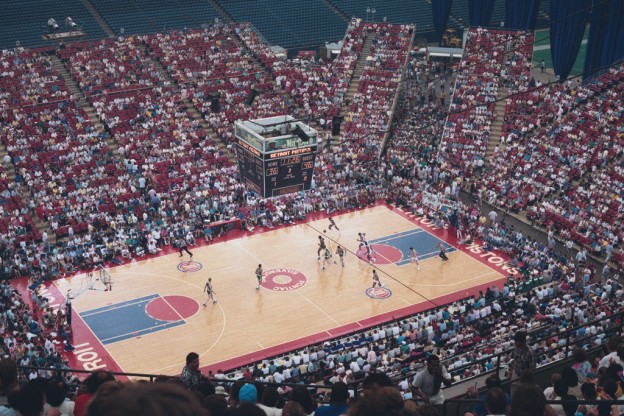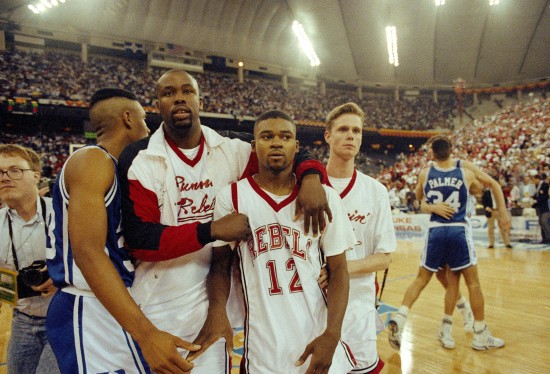The arrival of the 2016 Sweet 16 means that it’s the silver anniversary of the 1991 Sweet 16, with the anniversary of the 1991 Final Four not that far off.
It’s an anniversary which contains a mixture of sweetness and sadness… and also some disgust at what America has become.
First, the basketball, which is actually not central to this particular piece:
The sweetness of the 1991 Sweet 16 emerged in several ways. Roy Williams made the push to his first Final Four and national title game at Kansas. He defeated Bobby Knight (Sweet 16) and Nolan Richardson (Elite Eight) to reach the promised land.
Also in the 1991 Sweet 16, Dean Smith finally coached his North Carolina team to two wins and the Final Four berth which had eluded him for the previous eight seasons. Dean ushered North Carolina past Eastern Michigan and Temple to return to college basketball’s ultimate stage.
Duke and Mike Krzyzewski wanted revenge against Jerry Tarkanian and UNLV, but in order to make that main event a reality, they had to survive the Midwest Regional in Pontiac, Michigan. The Blue Devils weren’t the No. 1 seed in that regional — Ohio State was under then-coach Randy Ayers. Lou Carnesecca made one last run at the Final Four with St. John’s, and when the Red Storm upset Ohio State in the regional semifinals, it was Coach K against Coach Carnesecca for a spot in the Final Four. Krzyzewski won, and six days later against UNLV, he made history, captured in this memorable photo:
The sadness of the 1991 Sweet 16 and subsequent Final Four can be found in a few forms, starting with the people that are no longer with us.
Dean Smith and Tark the Shark died last year. Rick Majerus coached Utah into that Sweet 16, and he’s gone as well. College basketball — like college sports in general — is a coach’s game, because those are the men who stay over the long haul and give definition to the sport over time. Dean, Tark and Majerus were great coaches, but they were also unforgettable figures with personalities which made life infinitely more interesting.
The sadness of the 1991 Sweet 16 also flows from a few instances in which coaches and players fell short of a dream.
John Chaney and Mark Macon — an elite coach and one of Temple’s greatest players — twice made a regional final. They won their 1991 Sweet 16 game against Oklahoma State, but they fell short in the Elite Eight against North Carolina. Chaney returned to the Elite Eight three more times over the next 10 seasons, but each time, his Owls couldn’t quite get over the hump.
At least Lou Carnesecca made the Final Four at St. John’s (1985), but his loss to Duke in the 1991 Midwest Regional final marked his last great hurrah. He’s still alive and lighting up the world with his smile, but Carnesecca was a sentimental favorite in 1991, and he was stopped one win short of a Final Four sendoff.
*
Those are the sweetnesses and sadnesses from the 1991 Sweet 16.
Now, about that feeling of disgust…
Look at these three pictures below:

The Meadowlands, before Scott Burrell’s full-court pass and Tate George’s winning shot for UConn against Clemson.

The Silverdome, which now lies in disrepair, hosted the 1988 NBA Finals and the great Celtics-Pistons battles of the latter half of the 1980s. The building also hosted Super Bowl XVI in 1982, and pertinent to this piece, the 1991 Midwest Regional in which Duke beat St. John’s to move to the Final Four.

Charlotte Coliseum no longer exists. When it did, it hosted the 1994 Final Four and the 1991 Southeast Regional, plus other regionals and NCAA tournament games through the years.
You have already seen the RCA Dome in the Duke-UNLV photo above. In the cover image for this story, Seattle’s Kingdome is being imploded in March of 2000.
Why photos of these five buildings — the Kingdome, RCA Dome, the Izod Center (aka, the Meadowlands, aka, Brendan Byrne Arena), the Pontiac Silverdome, and the Charlotte Coliseum?
Here’s a startling fact about the 1991 Sweet 16 and Final Four: This is the last Sweet 16-Final Four combo in which all five venues — the four regionals and then the Final Four — were hosted by buildings which have either been demolished or are no longer in use.
The Kingdome, RCA Dome, Silverdome, and Charlotte Coliseum have all been imploded. The Izod Center is closed and will probably be imploded within two years.
Every subsequent NCAA tournament Sweet 16-Final Four combination has at least one venue which is active and not in danger of being demolished. (The Georgia Dome, an NCAA site for Sweet 16s and Final Fours in subsequent years, is eventually going to be demolished, but it’s not inactive just yet.)
Disgusting — is it too harsh a word to describe the demolition of five buildings, all of which provided so many great sports memories through the years?
I don’t think so.
Will I admit to being biased, out here in Seattle and no longer able to attend Friday practice at the Final Four, as I did in 1995 when Bryant “Big Country” Reeves of Oklahoma State shattered the backboard?
Yes — yes, I’m biased.
However, the scope of the extent to which American cities have demolished massive edificies under 25 to 30 years of age, just to satisfy the sports-revenue beast in an age of luxury suites and corporate hospitality, strikes me as off-putting. All the resources poured into those stadiums — and the memories those stadiums created — couldn’t have lasted half a century, at the very least? Alternative uses for these large and impressive (albeit not very charming, in the Kingdome’s case) facilities couldn’t have been found?
The 1991 Sweet 16 and Final Four occupy a dark and frustrating place in the history of the NCAA tournament and, by extension, the history of American sports.
The memories live on in our hearts, but those same memories can no longer be triggered by walking inside any of the five buildings which created them.


